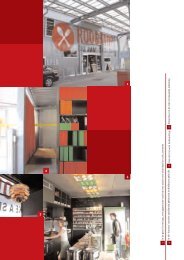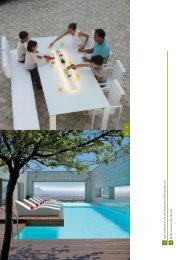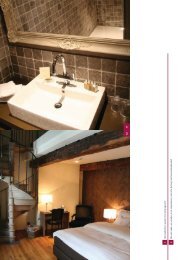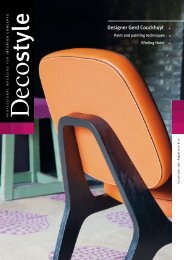Biënnale Interieur 2012 [ 6 ] - Decostyle
Biënnale Interieur 2012 [ 6 ] - Decostyle
Biënnale Interieur 2012 [ 6 ] - Decostyle
Create successful ePaper yourself
Turn your PDF publications into a flip-book with our unique Google optimized e-Paper software.
8<br />
3 4 5 6<br />
might experience our future living<br />
spaces, as part of the theme ‘Future<br />
Primitives’. As a result, we can be very<br />
radical, and explore that experience<br />
in a more abstract context: this can<br />
be a reflection on how we will use<br />
our personal space in the future,<br />
and what the impact might be of<br />
a variety of natural, technological,<br />
cultural and political developments.<br />
The Project rooms want to make clear<br />
that the <strong>Interieur</strong> Biennale is about<br />
interior living spaces, not just about<br />
design objects. An interior is a multidisciplinary,<br />
multi-sensorial concept:<br />
elements such as atmosphere,<br />
proportions, spatial feeling, light,<br />
smell, temperature, etc. are essential<br />
components of an interior.”<br />
In alphabetical order, the seven<br />
designers are David Bowen, Ross<br />
Lovegrove, Greg Lynn, Makkink &<br />
Bey, Muller Van Severen, Nendo and<br />
Troika. They develop the project<br />
rooms from the observation that our<br />
physical, sensorial and relational<br />
points of reference are becoming<br />
vaguer all the time. Within this fluid<br />
future, they go and explore the way<br />
in which new anchor points can be<br />
determined and translated within our<br />
future living environment.<br />
Context of 60 m 2<br />
The seven were asked to use their own<br />
artistic vision to reflect on a design and<br />
present the results within a context<br />
of 60 m 2 of space. Every future room<br />
needed to be surrounded by piazzas,<br />
which function as meeting places. The<br />
question is how they experience the<br />
essence of our future being and translate<br />
this into the context of a living<br />
space. The project rooms in themselves<br />
offer no added architectural<br />
value: all emphasis is on potentially<br />
relevant sensorial sensations.<br />
David Bowen (°1975) is an immediate<br />
example of <strong>Interieur</strong>’s broader<br />
vision. Bowen is an American artist<br />
who makes complex sculptural installations<br />
exploring the relationship<br />
between the natural and the mechanical.<br />
He often makes use of natural<br />
components such as light, wind and<br />
plants or techniques such as flying<br />
or floating in the air, to produce the<br />
interactive experiences inherent in<br />
his work. Bowen incorporates natural<br />
influences into his installations. Interfaces<br />
allow elements such as wind,<br />
waves, house and garden plants to<br />
control and steer mechanical structures,<br />
often resulting in unexpected<br />
and highly inspiring imagery.<br />
British designer and visionary<br />
Ross Lovegrove (°1958) demonstrates<br />
how the physical character of our<br />
three-dimensional world can be<br />
changed. Inspired by the logic and<br />
beauty of nature, his designs inhabit<br />
the crossroads between technology,<br />
materials science and intelligent<br />
organic forms.<br />
At present, his studio is working on<br />
the development of new materials,<br />
new structures in 3D printing and new<br />
free-form growth structures. In his<br />
installation for <strong>Interieur</strong>, he explores<br />
the informal relationships between<br />
materials and (moving) structures.<br />
The American architect and philosopher<br />
Greg Lynn (°1964) is a pioneer<br />
in redefining design through digital<br />
technology. He also produces complex<br />
but functional and ergonomic forms<br />
using CNC machinery. His studio is at<br />
the forefront in a number of sectors<br />
including environments, buildings,<br />
products, transportation etc. Lynn’s<br />
work is featured in the permanent<br />
collections of the foremost design and<br />
architecture museums worldwide,<br />
including the CCA, SFMoMA, ICA<br />
Chicago and MOMA. He is one of the<br />
most important representatives of<br />
‘blob architecture’, characterized by<br />
its biomorphic formal language. As a<br />
professor, he works for the University<br />
of Applied Arts in Vienna and teaches<br />
at the UCLA school of Architecture<br />
and Urban Design. He is also a guest<br />
professor at Yale University.<br />
Fourth in the row is the Makkink &<br />
Bey design studio, which will sound<br />
familiar to <strong>Decostyle</strong> readers. It is<br />
led by Dutch architect Rianne Makkink<br />
(°1964) and Dutch designer<br />
Jurgen Bey (°1965). Having been<br />
active across a very varied spectrum<br />
of contemporary applied art since<br />
3 Dutch partnership Jurgen Bey and Rianne Makkink 4 Ross Lovegrove, a British designer<br />
5 Oki Sato is at the heart of design studio Nendo 6 Lowie Vermeersch, curator of the <strong>Interieur</strong> <strong>Biënnale</strong> <strong>2012</strong>


![Biënnale Interieur 2012 [ 6 ] - Decostyle](https://img.yumpu.com/7876631/8/500x640/biennale-interieur-2012-6-decostyle.jpg)




![yoo Design Studio [ 6 ] - Decostyle](https://img.yumpu.com/7876175/1/184x260/yoo-design-studio-6-decostyle.jpg?quality=85)